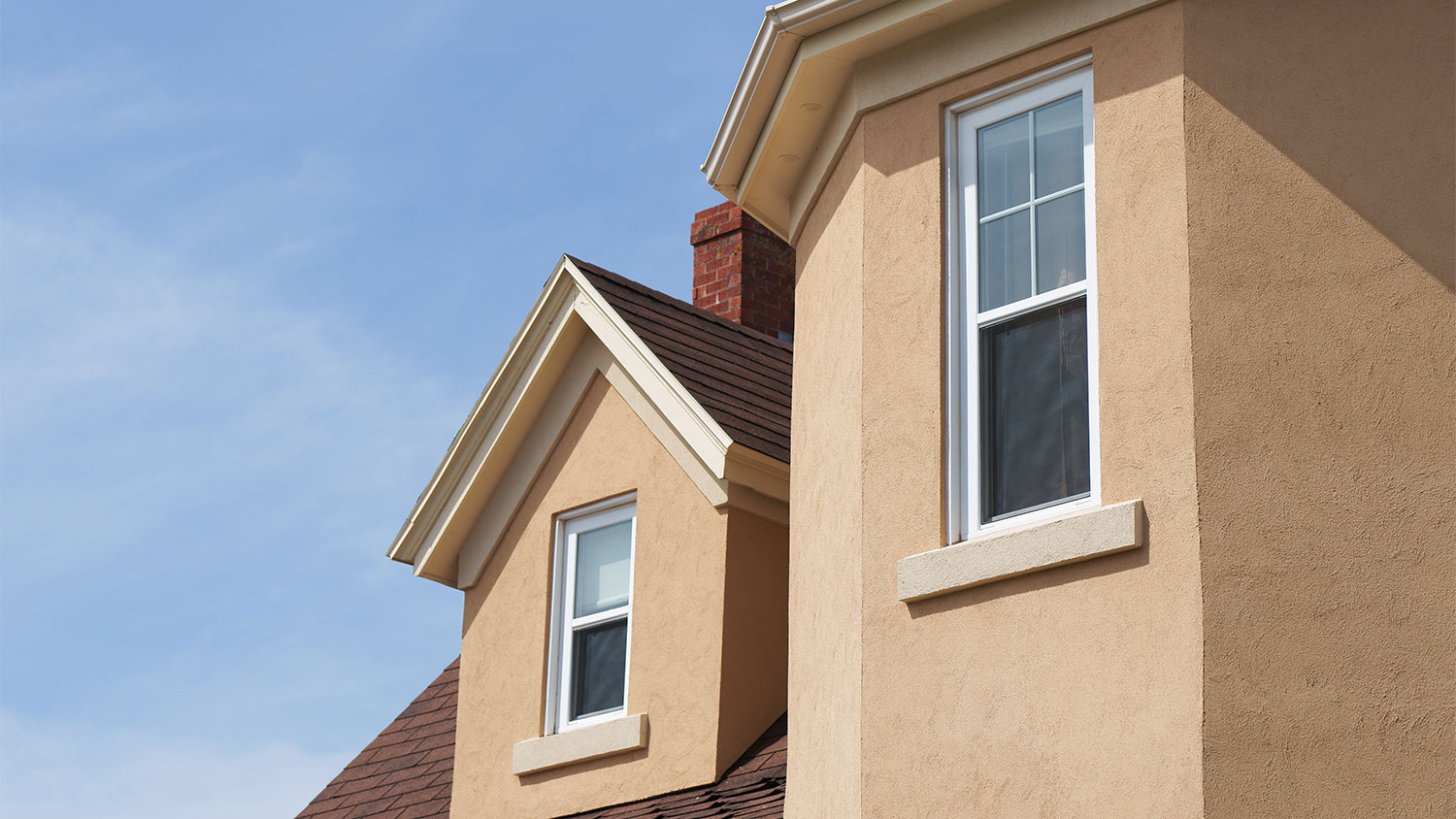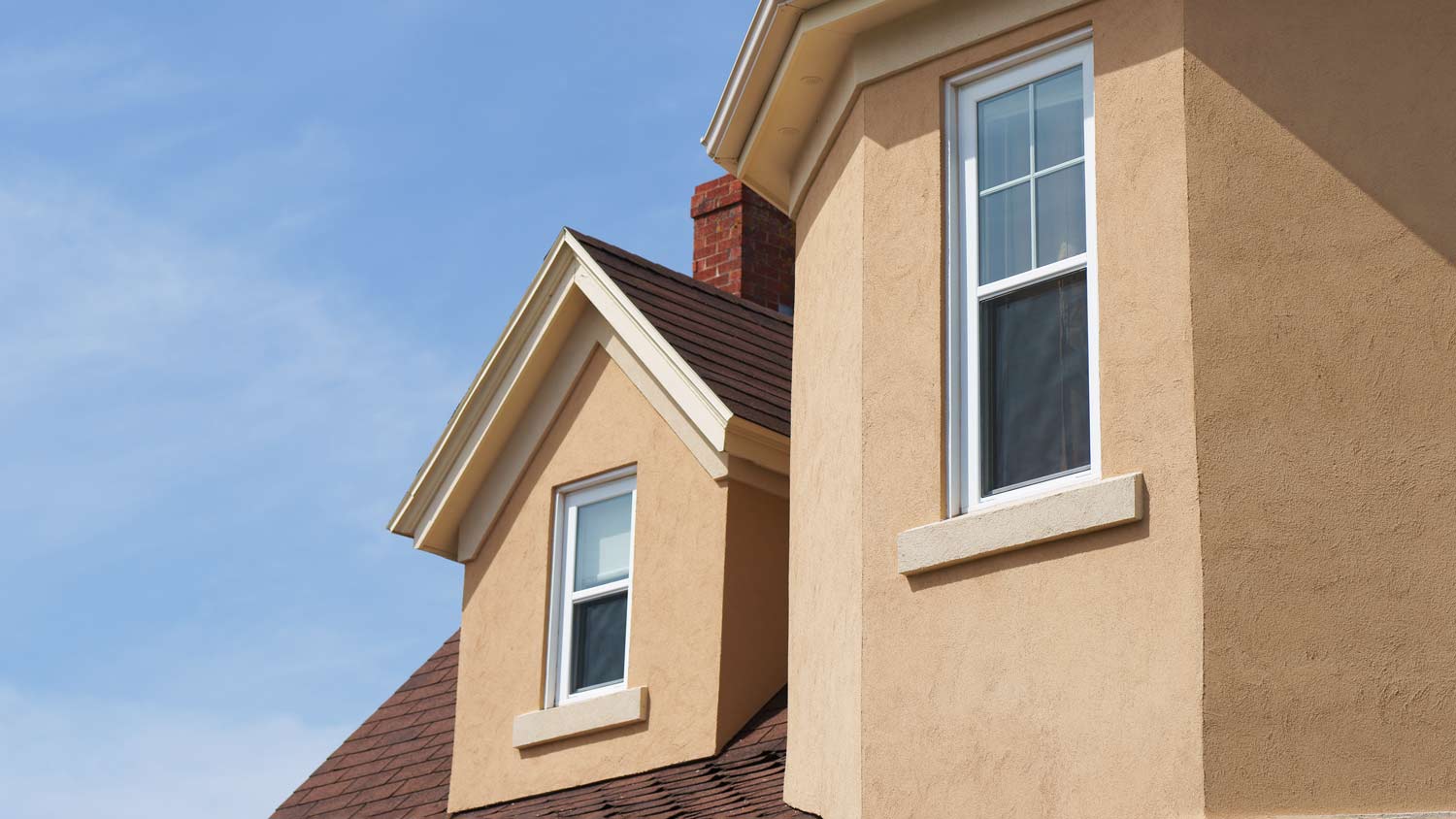
Discover the cost to stucco a house in 2025, including average prices, key factors, and tips to help you budget and plan your stucco project with confidence.
Discover the best material for your home makeover


Stucco costs an average of $7 to $9 per square foot, while brick costs about $9 to $28 per square foot.
Durable brick is low-maintenance and can last for a century or longer.
Stucco has a lifespan of 60 to 80 years but is prone to cracking.
Although it has a timeless beauty, brick isn’t as customizable as stucco.
Stucco and brick are two durable and attractive building materials, making them popular choices for homeowners. However, each has its distinct advantages and drawbacks. Use this guide to compare stucco versus brick and decide which is best for your home based on factors like your climate, the amount of effort you’re able to put into installation and repair, and your desired customization options.
Stucco and brick are both popular choices for home exteriors, but they differ quite a bit in terms of their composition and appearance. Stucco is a cement-based substance that’s applied in layers and can be customized with a variety of hues and textures. Brick, made from clay and shale, provides a timeless look and can last for a century or longer.
These building materials differ in other ways as well, including cost and upkeep requirements.

Stucco is made from a combination of Portland cement, sand, water, and lime. These ingredients are mixed together to create a durable exterior finish that’s applied in layers. The material is a great choice for homeowners seeking versatile design options and a balance of affordability and durability.
| Pros | Cons |
|---|---|
| Cost-effective | Requires more maintenance than brick |
| Aesthetically versatile | Prone to cracking and fading |
| Fire-resistant | Less moisture-resistant than brick |
Best for:
Homes in warm, dry climates
Homeowners seeking aesthetic versatility
Homeowners on a budget
Stucco is generally more affordable than brick, and it offers a wider variety of textures, colors, and finishes, from smooth and sleek to highly textured. It’s also highly fire-resistant thanks to its composition of cement, sand, and lime, which helps prevent the spread of fires from the exterior to the interior of the home.
Stucco can also be applied to a wide variety of surfaces, which means it can work for diverse architectural styles and needs. And while it’s not as durable as brick, it’s more durable than materials like vinyl, lasting for 60 to 80 years with proper maintenance.
Unlike brick, stucco is prone to developing cracks over time due to factors like temperature and humidity fluctuations, extreme weather, and the natural settling of a house. These cracks can cause moisture to penetrate the material, leading to mold and mildew, so it’s not the best fit for wetter climates.
To avoid moisture problems, you need to inspect and maintain stucco regularly—more so than you’d need to do with brick. Stucco also isn’t as long-lasting as brick, and it can take several weeks to fully cure, which adds complexity and time to the installation process.

Brick primarily comprises a mix of natural clay and shale. These materials are then crushed and ground into a fine powder before being molded into brick shapes and fired in a kiln at high temperatures. Brick exteriors are ideal for homeowners seeking a classic appearance with exceptional durability and longevity.
| Pros | Cons |
|---|---|
| Low-maintenance | Limited design options |
| Durable and resistant to fire and moisture | More expensive |
| Reduces exterior noise |
Best for:
Homeowners seeking a timeless appearance
Homes in extreme climates
Homeowners who prioritize durability and longevity
Since brick isn’t prone to cracking like stucco, it doesn’t require as much maintenance or regular inspections as stucco. It’s also more moisture-resistant, which means you won’t have to worry about mold and mildew problems. In addition, brick is highly fire-resistant and one of the most durable materials you can find, often lasting for centuries, so it’s a particularly great choice for areas prone to extreme weather.
Brick also typically boosts a home’s resale value more than stucco, which can help to offset its higher upfront costs. Plus, brick may provide better noise reduction than stucco, making it a nice choice for areas with a lot of street noise.
Brick doesn’t offer nearly as many texture and design options as stucco. It’s typically only available in natural earth tones, like red, brown, and gray. However, you can paint brick in any color. Brick also costs significantly more than stucco to install.
Before deciding whether brick or stucco is the best option for your home, it helps to compare them based on factors like appearance, durability, and price.
Stucco and brick both have aesthetic appeal. Stucco offers a clean, modern look with a wide range of design options. It’s a particularly great fit for contemporary and Southwestern-style homes. Meanwhile, brick offers a classic, timeless appearance that makes it highly suitable for traditional architectural styles.
Stucco is the clear winner in terms of customization options. It comes in a wide range of colors, textures, and styles, allowing you to tailor the design to your unique style sensibility. Brick is far more limited in terms of colors and texture, but it can be painted in any hue.
Brick is more durable than stucco, often lasting for hundreds of years thanks to its exceptional resistance to damage, fire, and moisture. This makes it a popular choice for homes in regions with severe weather. However, stucco is still longer-lasting than many other exterior choices, with a lifespan of around 60 to 80 years with proper maintenance.
The cost of brick is significantly higher than stucco, typically ranging from $9 to $28 per square foot. Meanwhile, stucco costs between $7 and $9 per square foot. However, it’s worth noting that brick is more durable and lasts longer, so it may cost less over time compared to stucco, which requires more maintenance and repairs and has a shorter lifespan.
Brick and stucco are both relatively complex to install, so neither is suitable for a DIY installation. However, stucco installations are typically a bit less labor-intensive when you hire a pro who installs stucco. Installing stucco involves several steps depending on what material it’s being applied over, but it typically entails applying some sort of bonding agent before a scratch coat. The scratch coat needs to harden for around two days, with occasional misting to keep it moist, before applying a finishing coat.
Brick installations require several steps as well, starting with cleaning the surface of debris, loose plaster, and paint. Metal flashing is attached before laying bricks with construction adhesive and mortaring the joints. Wall ties are used to attach the bricks to the sheathing every four courses. Both brick and stucco take a similar amount of time to install, but with stucco, most of that time is spent waiting for the material to harden and cure.
Brick is generally easier to repair than stucco. Minor damage can often be fixed by replacing individual bricks or repointing mortar joints. Many handy homeowners can do these repairs themselves in a free afternoon.
Stucco repairs, like fixing cracks, must be done promptly to prevent moisture problems. They typically require more skill and expertise to ensure a seamless finish, so they’re best left to a professional stucco contractor near you.
Brick’s durability makes it the best low-maintenance choice. It’s naturally resistant to rotting, warping, and insect damage, as well as projectiles and weather damage. Maintenance typically involves repointing mortar joints and replacing a brick or two over time, but these are very occasional tasks.
Stucco is a porous material, making it susceptible to discoloration, so it needs to be cleaned regularly to maintain its appearance and prevent staining. It should also be inspected often for any cracks resulting from temperature changes or house settling; these will need to be patched quickly to prevent water damage. In addition, the color of stucco tends to fade over time, so it often needs to be repainted every 5 to 8 years or so.
Given that brick can last for centuries, it’s the clear winner in terms of lifespan. However, stucco is still a long-lasting material compared to siding types like vinyl, often lasting for 60 years or more with regular maintenance.
Both brick and stucco can increase home value, but brick typically boosts a home’s resale value more than stucco for several reasons. One reason is that brick is one of the most durable and long-lasting exterior materials around. It’s also very low maintenance and resistant to weather damage, fires, moisture, and pests. Plus, it has a timeless appearance that many prospective buyers covet, as well as superior sound insulation compared to stucco.
Although brick and stucco are both considered eco-friendly materials, brick has a slight edge when it comes to environmental impact. Once stucco is removed, it can’t be reused, while bricks can continue their life cycle with another use or get recycled. Brick is also more eco-friendly to manufacture—it contains a higher percentage of recycled materials than stucco.
Applying stucco over brick is one way to extend the life of your siding by layering these two durable materials. You can change the look of your home’s exterior or simulate the look of brick with stucco, but your brick needs to be in good condition and properly prepared for a stucco overlay to work. A pro who specializes in stucco can assess your existing brick siding and determine if installing stucco over it is possible.
- Great work, very happy with it
Melvin and Austin are professional, knowledgeable and thorough. Super friendly and honest. We cannot say enough good things about GOAT home inspections. We definitely recommend and trust them
Matt at Airquo cleaned windows and screens both inside and out Job done well and in a timely manner. Matt was easy to work with as every time he was scheduled to come it was raining. We finally found a date that worked for us and the weather.
I HIGHLY recommend Florida Professional Roofing Services. I needed to have flashing around the chimney repaired on the home I just bought. The listing stated the roof was new in 2019. The roofers who installed the new roof never changed the flashing, and it was now leaking. The flashing,...
The whole experience from start to finish was truly professional. Started on time every day finish the job on time. And the price that was quoted was the price that I paid, there was no request for extras. Couldnâ t have hired a better company.
When the hurricane was moving in from the gulf Chris and his crew came out and worked all day through the rain to take trees and limbs down that were potentially hazardous . I appreciated their hard work and willingness to come out at the 11th hour.
Excellent, all problems originally found plus some stuff found during the work was fixed.
They did a great job in the repair work.
KAJ 1 installed luxury vinyl plank throughout most of my home. Bacilio, who is personable and professional, is knowledgeable and skilled regarding floor installation. In fact, when he delivered the planks, he demonstrated to me numerous ways to install them to achieve a variety of patterns...
Mark and his team are professional, prompt, and extremely customer service oriented. They did an excellent job on replacing my box bay window and left the work area spotless before they left. I highly recommend them!
From average costs to expert advice, get all the answers you need to get your job done.

Discover the cost to stucco a house in 2025, including average prices, key factors, and tips to help you budget and plan your stucco project with confidence.

Discover the average stucco repair cost, key price factors, and ways to save. Get expert tips to budget your stucco repair project with confidence.

Get transparent stucco inspection cost info. Learn what impacts price, how to save, and what to expect before hiring a pro for your stucco inspection.

Parging and stucco are similar in application and can look identical, but there are some key differences in application, cost, and longevity.

Stucco is a long-lasting, durable siding material, but cracks can shorten its lifespan and cause serious problems. Learn when to worry about stucco cracks.

Tired of that old, moldy stucco? Learn how to remove stucco siding the quick and easy way to save a few thousand dollars on siding removal costs.